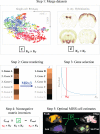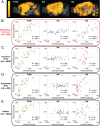Matrix Inversion and Subset Selection (MISS): A pipeline for mapping of diverse cell types across the murine brain
- PMID: 35363567
- PMCID: PMC9168512
- DOI: 10.1073/pnas.2111786119
Matrix Inversion and Subset Selection (MISS): A pipeline for mapping of diverse cell types across the murine brain
Abstract
The advent of increasingly sophisticated imaging platforms has allowed for the visualization of the murine nervous system at single-cell resolution. However, current experimental approaches have not yet produced whole-brain maps of a comprehensive set of neuronal and nonneuronal types that approaches the cellular diversity of the mammalian cortex. Here, we aim to fill in this gap in knowledge with an open-source computational pipeline, Matrix Inversion and Subset Selection (MISS), that can infer quantitatively validated distributions of diverse collections of neural cell types at 200-μm resolution using a combination of single-cell RNA sequencing (RNAseq) and in situ hybridization datasets. We rigorously demonstrate the accuracy of MISS against literature expectations. Importantly, we show that gene subset selection, a procedure by which we filter out low-information genes prior to performing deconvolution, is a critical preprocessing step that distinguishes MISS from its predecessors and facilitates the production of cell-type maps with significantly higher accuracy. We also show that MISS is generalizable by generating high-quality cell-type maps from a second independently curated single-cell RNAseq dataset. Together, our results illustrate the viability of computational approaches for determining the spatial distributions of a wide variety of cell types from genetic data alone.
Keywords: cell-type maps; deconvolution; neuroanatomy; transcriptomics.
Conflict of interest statement
The authors declare no competing interest.
Figures





Similar articles
-
Computational solutions for spatial transcriptomics.Comput Struct Biotechnol J. 2022 Sep 1;20:4870-4884. doi: 10.1016/j.csbj.2022.08.043. eCollection 2022. Comput Struct Biotechnol J. 2022. PMID: 36147664 Free PMC article. Review.
-
DNA methylation atlas of the mouse brain at single-cell resolution.Nature. 2021 Oct;598(7879):120-128. doi: 10.1038/s41586-020-03182-8. Epub 2021 Oct 6. Nature. 2021. PMID: 34616061 Free PMC article.
-
Morphological diversity of single neurons in molecularly defined cell types.Nature. 2021 Oct;598(7879):174-181. doi: 10.1038/s41586-021-03941-1. Epub 2021 Oct 6. Nature. 2021. PMID: 34616072 Free PMC article.
-
EASI-FISH for thick tissue defines lateral hypothalamus spatio-molecular organization.Cell. 2021 Dec 22;184(26):6361-6377.e24. doi: 10.1016/j.cell.2021.11.024. Epub 2021 Dec 6. Cell. 2021. PMID: 34875226
-
Methods and tools for spatial mapping of single-cell RNAseq clusters in Drosophila.Genetics. 2021 Apr 15;217(4):iyab019. doi: 10.1093/genetics/iyab019. Genetics. 2021. PMID: 33713129 Free PMC article. Review.
Cited by
-
Cell-type-specific densities in mouse somatosensory cortex derived from scRNA-seq and in situ RNA hybridization.Front Neuroanat. 2023 Mar 2;17:1118170. doi: 10.3389/fnana.2023.1118170. eCollection 2023. Front Neuroanat. 2023. PMID: 37007642 Free PMC article.
-
Connectome-based biophysics models of Alzheimer's disease diagnosis and prognosis.Transl Res. 2023 Apr;254:13-23. doi: 10.1016/j.trsl.2022.08.008. Epub 2022 Aug 27. Transl Res. 2023. PMID: 36031051 Free PMC article. Review.
-
Searching for the cellular underpinnings of the selective vulnerability to tauopathic insults in Alzheimer's disease.Commun Biol. 2025 Feb 7;8(1):195. doi: 10.1038/s42003-025-07575-1. Commun Biol. 2025. PMID: 39920421 Free PMC article.
References
MeSH terms
Grants and funding
LinkOut - more resources
Full Text Sources
Miscellaneous

